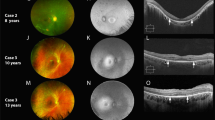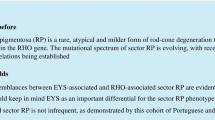Abstract
Purpose
To report the clinical (anatomic and functional) and genetic findings of Wagner Syndrome (WS) in a Portuguese family.
Methods
Nine members of the family agreed to be examined. All had complete clinical eye examinations. The proband and selected patients underwent color fundus photography, spectral domain optical coherence tomography (SD-OCT), automatic static white-on-white computerized perimetry, and electrophysiology assessment (flash ERG, multifocal(mf) ERG and dark adaptometry). A pedigree was constructed based on interviews with known affected subjects. Genomic DNA samples derived from venous blood were collected from all affected family members examined.
Results
Twenty-eight family members are affected. This family has the typical features of Wagner Syndrome, namely an empty vitreous cavity with veils, mild myopia and cataract. Four examined patients underwent vitreoretinal surgery due to abnormal peripheral vitreoretinal adhesions with peripheral retinal traction (n = 3). Retinal detachment was observed in 5 of the examined subjects. Four of them occurred between the ages of 5 and 15 years. Chorioretinal atrophy is also a frequent finding which results in moderate to severe visual field and advanced rod-cone dystrophy from younger ages, also confirmed by absence of scotopic function on dark adaptation. The macular dysfunction on mfERG was profound and of early onset. A heterozygous mutation in intron 7 of the VCAN gene (c.4004-1G > A) was found.
Conclusions
We described a rare autosomal dominant vitreoretinopathy with near complete penetrance in a Portuguese family. Abnormal peripheral vitreoretinal adhesions, retinal detachment and chorioretinal atrophy are present in most of the examined individuals at young ages. Early onset of advanced visual field and electrophysiologic abnormalities were observed in this family. We also added relevant information to the literature by reporting our experience in surgical management of Wagner Syndrome patients with, and at risk of, retinal detachment.







Similar content being viewed by others
Abbreviations
- WS:
-
Wagner Syndrome
- SD-OCT:
-
Spectral domain optical coherence tomography
- ERG:
-
Electroretinograms
- ISCEV:
-
International Society for Clinical Electrophysiology of Vision
- BCVA:
-
Best corrected visual acuity
- IOL:
-
Intraocular lens
- PPV:
-
Pars plana vitrectomy
- RD:
-
Retinal detachment
- NLP:
-
No light perception
- GAG:
-
Glycosaminoglycan
References
Hinton DR (2006) Basic clinical science and inherited retinal diseases. Philadelphia. PA: Elsevier Mosby 519-538
Wagner H (1938) Ein bisher unbekanntes des auges (degeneration hyaloideo-retinalis hereditaria), beobachtet im Kanton Zurich. Klin Monatsbl Augenheilkd 100:840–857
Kloeckener-Gruissem B, Amstutz C (2009) VCAN-related vitreoretinopathy. In: Pagon RA, Bird TD, Dolan CR, Stephens K, Adam MP (eds) Gene Reviews. University of Washington, Seattle (WA)
Graemiger RA, Niemeyer G, Schneeberger SA, Messmer EP (1995) Wagner vitreoretinal degeneration. Follow-up of the original pedigree. Ophthalmology 102:1830–1839
Stickler GB, Belau PG, Farrell FJ et al (1965) Hereditary progressive arthroophthalmopathy. Mayo Clin Proc 40:433
Stickler GB, Pugh DG (1967) Hereditary progressive arthroophthalmopathy. II. Additional observations on vertebral abnormalities, a hearing defect and a report of a similar case. Mayo Clin Proc 42:495
Edwards AO (2008) Clinical features of the congenital vitreoretinopathies. Eye 22:1233–1242
Snead MP, Yates JR (1999) Clinical and molecular genetics of Stickler syndrome. J Med Genet 36(5):353–359
McAlinden A, Majava M, Bishop PN et al (2008) Missense and nonsense mutations in the alternatively-spliced exon 2 of COL2A1 cause the ocular variant of Stickler syndrome. Hum Mutat 29(1):83–90
Richards AJ, Martin S, Yates JR et al (2000) COL2A1 Exon 2 mutations: relevance to the Stickler and Wagner syndromes. Br J Ophthalmol 84(4):364–371
Mukhopadhyay A, Nikopoulos K, Maugeri A et al (2006) Erosive vitreoretinopathy and Wagner disease are caused by intronic mutations in CSPG2/Versican that result in an imbalance of splice variants. Invest Ophthalmol Vis Sci 47:3565–3572
Jansen LM (1962) Degeratio hyaloideo-retinalis herditaria. Ophthalmologica 144:348–363
Kloeckener-Gruissem B, Amstutz C (2009) VCAN-related Vitreoretinopathy. GeneReviews® [internet]. Seattle (WA): university of Washington. Seattle 1993-2014
Perveen R, Hart-Holden N, Dixon MJ et al (1999) Refined genetic and physical localization of the Wagner disease (WGN1) locus and the genes CRTL1 and CSPG2 to a 2- to 2.5-cM region of chromosome 5q14.3. Genomics 57(2):219–226
Theocharis DA, Skandalis SS, Noulas AV et al (2008) Hyaluronan and chondroitin sulfate proteoglycans in the supramolecular organization of the mammalian vitreous body. Connect Tissue Res 49:124–128
Miyamoto T, Inoue H, Sakamoto Y et al (2005) Identification of a novel splice site mutation of the CSPG2 gene in a Japanese family with Wagner syndrome. Invest Ophthalmol Vis Sci 46:2726–2735
Zhao X, Russell P (2005) Versican splice variants in human trabecular meshwork and ciliary muscle. Mol Vis 11:603–608
Kloeckener-Gruissem B, Bartholdi D, Abdou MT, Zimmermann DR, Berger W (2006) Identification of the genetic defect in the original Wagner syndrome family. Mol Vis 12:350–355
Meredith SP, Richards AJ, Flanagan DW, Scott JD, Poulson AV, Snead MP (2007) Clinical characterisation and molecular analysis of Wagner syndrome. Br J Ophthalmol 91:655–659
Ronan SM, Tran-Viet KN, Burner EL, Metlapally R, Toth CA, Young TL (2009) Mutational hot spot potential of a novel base pair mutation of the CSPG2 gene in a family with Wagner syndrome. Arch Ophthalmol 127:1511–1519
Brezin AP, Nedelec B, Barjol A, Rothschild PR, Delpech M, Valleix S (2011) A new VCAN/versican splice acceptor site mutation in a French Wagner family associated with vascular and inflammatory ocular features. Mol Vis 17:1669–1678
Hood DC, Bach M, Brigell M, Keating D, Kondo M, Lyons JS, Marmor MF, McCulloch DL, Palmowski-Wolfe AM (2012) ISCEV standard for clinical multifocal electroretinography (2011 edition). Doc Ophthalmol 124:1–13
Brown DM, Kimura AE, Weingeist TA, Stone EM (1994) Erosive vitreoretinopathy: a new clinical entity. Ophthalmology 101(4):694–704
Maumenee IH, Stoll HU, Mets MB (1982) The Wagner syndrome versus hereditary arthroophthalmopathy. Trans Am Ophthalmol Soc 80:349–365
Carroll C, Papaioannou D, Rees A, Kaltenthaler E (2011) The clinical effectiveness and safety of prophylactic retinal interventions to reduce the risk of retinal detachment and subsequent vision loss in adults and children with Stickler syndrome: a systematic review. Health Technol Assess 15(16):iii–xiv 1-62
Fincham GS, Pasea L, Carroll C, McNinch AM, Poulson AV, Richards AJ, Scott JD, Snead MP (2014) Prevention of retinal detachment in Stickler syndrome: the Cambridge prophylactic Cryotherapy protocol. Ophthalmology, pii S0161-6420(14):00186–00189
Black GC, Perveen R, Wiszniewski W, Dodd CL, Donnai D, McLeod D (1999) A novel hereditary developmental vitreoretinopathy with multiple ocular abnormalities inherited vitreoretinopathies localizing to a 5-cM region of chromosome 5q13–q14. Ophthalmology 106:2074–2081
Funding
No funding was received for this research.
Author information
Authors and Affiliations
Corresponding author
Ethics declarations
Conflict of interest
All authors certify that they have no affiliations with or involvement in any organization or entity with any financial interest (such as honoraria; educational grants; participation in speakers’ bureaus; membership, employment, consultancies, stock ownership, or other equity interest; and expert testimony or patent-licensing arrangements), or non-financial interest (such as personal or professional relationships, affiliations, knowledge or beliefs) in the subject matter or materials discussed in this manuscript.
Ethical approval
All procedures performed in studies involving human participants were in accordance with the ethical standards of the institutional and/or national research committee and with the 1964 Helsinki declaration and its later amendments or comparable ethical standards.
Informed consent
Informed consent was obtained from all individual participants included in the study.
Financial Support
None
Rights and permissions
About this article
Cite this article
Araújo, J.R., Tavares-Ferreira, J., Estrela-Silva, S. et al. WAGNER syndrome: anatomic, functional and genetic characterization of a Portuguese family. Graefes Arch Clin Exp Ophthalmol 256, 163–171 (2018). https://doi.org/10.1007/s00417-017-3800-0
Received:
Revised:
Accepted:
Published:
Issue Date:
DOI: https://doi.org/10.1007/s00417-017-3800-0




